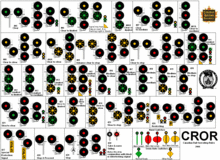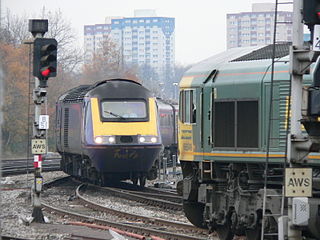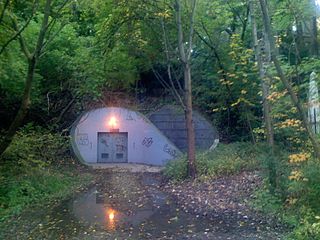This article includes a list of general references, but it lacks sufficient corresponding inline citations .(October 2012) |
The Canadian Rail Operating Rules is a set of operating rules for railways in Canada. It is used by every Canadian railway.
This article includes a list of general references, but it lacks sufficient corresponding inline citations .(October 2012) |
The Canadian Rail Operating Rules is a set of operating rules for railways in Canada. It is used by every Canadian railway.
The Canadian Rail Operating Rules are intended to enhance railway safety. The rules cover employee responsibilities, signalling equipment, procedures for safe train movement, dealing with accidents and other topics that directly and indirectly affect railway safety.
The full set of Canadian Rail Operating Rules is divided into 22 categories:
Canada uses a signal system similar to the United States' signalling system, in that signals are either one-, two- or three-headed, and each one can show any of the aspects described above. There are different signal systems for rapid transit and other urban rail systems in Canada. There are also various signs that can be placed on a signal mast, which can modify a signal. An "L" plate upgrades any medium-speed signal to limited speed. An "A" plate is indicative of an absolute signal: it cannot be passed at all-red signals. An "R" plate upgrades a regular all-red signal from a stop-and-proceed signal to a restricting signal. A "DV" plate makes a slow-speed signal into diverging speed. Canadian railways use miles per hour not kilometres per hour, even though road speed limits are in kilometres per hour.
This is a list of the different speed limits defined by the CROR: [1]
The signal system explained here assumes the signal displaying has three heads. Any signal indication that has a solid red on the third head down can also be indicated with just two heads. Any indication with solid red lights on the second and third heads down can be indicated with just one head. For example a green light on the top head still means proceed at track speed, no speed restrictions or stops within the next three signals, regardless of if the signal has only one head or not. A flashing yellow on the second head down with red on top and bottom would still mean limited to stop even if there was no bottom head. This article will also indicate a signal indication by stating the colour of the signal over another colour of the signal over the next colour of the signal, for example red over flashing green over flashing yellow. A signal can indicate some sort of restriction two signals in advance by flashing a yellow on the top head. If the signal heads are staggered, as in, one light is on the left side of the mast, then the next one down to the right side of the mast, etc., then that means signals are controlled by the automated CTC signal system, and that stop signals are not absolute. If all the heads are on one side or the other side of the mast, then a stop signal is absolute. If the signal is absolute, then the stop indication means stop and do not go until the signal improves or the crew gets written permission from RTC to proceed. If they are not absolute, the signal is controlled by CTC, and the crew may go at restricted speed after a complete stop. [2] [3] Any signal that is ambiguous or otherwise unclear or if any of the lights are not showing, then the signal must be read as if they are showing the most restrictive aspects they can display (that is, red) unless a solid yellow is on the bottom head, in which case the signal is interpreted as a restricting signal, because if the other signals are extinguished, they must be interpreted as if they are solid red, and a red over red over yellow does in fact mean restricting. [4]

(An L plate on the signal mast makes any medium-speed indication a limited-speed upgrade)
(A slow-speed indication becomes diverging speed if the mast has a DV plate)

Traffic lights, traffic signals, or stoplights – also known as robots in South Africa and Namibia – are signaling devices positioned at road intersections, pedestrian crossings, and other locations in order to control the flow of traffic.

A railway signal is a visual display device that conveys instructions or provides warning of instructions regarding the driver's authority to proceed. The driver interprets the signal's indication and acts accordingly. Typically, a signal might inform the driver of the speed at which the train may safely proceed or it may instruct the driver to stop.

Railway signalling (BE), or railroad signaling (AE), is a system used to control the movement of railway traffic. Trains move on fixed rails, making them uniquely susceptible to collision. This susceptibility is exacerbated by the enormous weight and inertia of a train, which makes it difficult to quickly stop when encountering an obstacle. In the UK, the Regulation of Railways Act 1889 introduced a series of requirements on matters such as the implementation of interlocked block signalling and other safety measures as a direct result of the Armagh rail disaster in that year.

The Colwich rail crash occurred on the evening of Friday 19 September 1986 at Colwich Junction, Staffordshire, England. It was significant in that it was a high speed collision between two packed express trains. One driver was killed, but no passengers died because of the great strength of the rolling stock involved, which included examples of Mk1, Mk2 and Mk3 coaches.

The 1995 Russell Hill subway accident was a deadly train crash that occurred in Toronto, Ontario, Canada, on Line 1 Yonge–University of the Toronto subway on August 11, 1995. Three people were killed and 30 were taken to hospital with injuries when one train rear-ended another train. The subway line was shut down for five days following the incident. Investigations found that human error and a design flaw in the mechanical safety devices caused this accident. It remains the deadliest accident in a rapid transit system in Canadian history.

The railway signalling system used across the majority of the United Kingdom rail network uses lineside signals to control the movement and speed of trains.
Australian railway signalling varies between the States of Australia, because the individual States are responsible for the railway systems within their own borders, with, historically, no need to co-ordinate between states except at the boundaries.
Railway signals in Germany are regulated by the Eisenbahn-Signalordnung. There are several signalling systems in use, including the traditional H/V (Hauptsignal/Vorsignal) system.
Standards for North American railroad signaling in the United States are issued by the Association of American Railroads (AAR), which is a trade association of the railroads of Canada, the US, and Mexico. Their system is loosely based on practices developed in the United Kingdom during the early years of railway development. However, North American practice diverged from that of the United Kingdom due to different operating conditions and economic factors between the two regions. In Canada, the Canadian Rail Operating Rules (CROR) are approved by the Minister of Transport under the authority of the Railway Safety Act. Each railway company or transit authority in Canada issues its own CROR rulebook with special instructions peculiar to each individual property. Among the distinctions are:
The Toronto subway uses a variety of signalling systems on its lines, consisting of a combination of fixed block signalling and moving block signalling technologies.
The Bourne End rail crash occurred on 30 September 1945 when a sleeper train from Perth to London Euston derailed, killing 43. The cause was driver error, possibly compounded by ambiguous signalling regulations.

In traffic engineering, there are regional and national variations in traffic light operation. This may be in the standard traffic light sequence or by the use of special signals.

North American railroad signals generally fall into the category of multi-headed electrically lit units displaying speed-based or weak route signaling. Signals may be of the searchlight, color light, position light, or color position light types, each displaying a variety of aspects which inform the locomotive operator of track conditions so that they may keep their train under control and able to stop short of any obstruction or dangerous condition.

Railway semaphore signal is one of the earliest forms of fixed railway signals. This semaphore system involves signals that display their different indications to train drivers by changing the angle of inclination of a pivoted 'arm'. Semaphore signals were patented in the early 1840s by Joseph James Stevens, and soon became the most widely used form of mechanical signal. Designs have altered over the intervening years, and colour light signals have replaced semaphore signals in most countries, but in a few they remain in use.
The current French railway signalling system is in force on the Réseau Ferré de France since 1930, when the code Verlant was applied.

Japanese railway signals, according to the ministerial decree defining technical standards of railways, are defined as indicating operational conditions for railway staff driving trains.

Pulse code cab signaling is a form of cab signaling technology developed in the United States by the Union Switch and Signal corporation for the Pennsylvania Railroad in the 1920s. The 4-aspect system widely adopted by the PRR and its successor railroads has become the dominant railroad cab signaling system in North America with versions of the technology also being adopted in Europe and rapid transit systems. In its home territory on former PRR successor Conrail owned lines and on railroads operating under the NORAC Rulebook it is known simply as Cab Signaling System or CSS.
Swiss railway signalling describes the railway signalling systems used in Switzerland by the different railway companies. There are two main types of signal, used up to 160 km/h, above which speed cab signalling is required.

The Italian railway signalling currently in use, employed on the Italian national railway network, is regulated by the "Regulation on signals", issued by the Italian railway infrastructure manager, RFI.
Belgian railway signalling is the signalling in effect on the Belgian rail network currently operated by Infrabel.